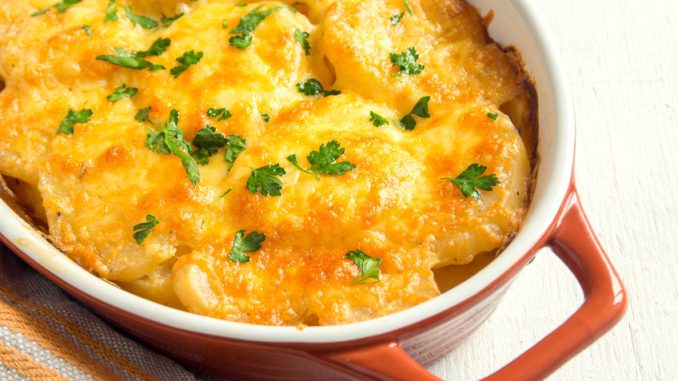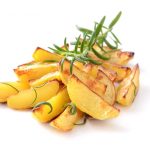
Dauphinoise potatoes are in their own right a wonderful comfort food. They are the perfect accompaniment to any main meal, whether it be roast chicken, pork chops or steak. It is a really nice dish in its own right for a meat-free dinner.
The potato is offered to us in rich creamy slices with a fragrant and tantalizing garlic note. They also have a crunchy topping for a little bit of texture. It is also called a potato gratin which you see on American web-sites.
Gratin dauphinoise originally comes from the Dauphiné region of South Eastern France. It dates back to 1788 which is just after the American Revolution and the start of troubles in France which were to lead to their own Revolution.
Traditionally, it is a dish of sliced potatoes baked in cream, usually with milk but not always and with this soft note of garlic. It should be cooked slowly at a low temperature, to create an indulgent melting potato texture with a crisp and crunchy top.
The amount of garlic to use depends on how you want to have your breath smell. Given everyone will want this dish it wont really matter. If you want a roasted version using herbs and garlic then try that other great classic potato side dish Parmentier potatoes. We sometimes have both just for the shear hell of it.
It is also a great way to make use of those floury potatoes that you grow in the garden and of course your abundant garlic supply.
Worth trying. Here’s how we make dauphinoise potatoes.
[Please note we are an affiliate marketing partner and will make a sales commission if you purchase any items through our affiliate links. Please read our affiliate disclosure]
Equipment:
Ingredients:
- 1 tbsp olive oil
- 1 large onion, finely sliced
- 1kg (2.5lb) large floury potatoes such as Maris Piper or King Edward, peeled. This equates to about 4 large potatoes.
- butter, for greasing
- 250ml whole milk but you can use the equivalent of semi-skimmed
- 250ml double cream
- 2 to 4 garlic cloves, peeled and lightly crushed
- 1 bay leaf (optional)
- ¼ tsp ground nutmeg
- 70g hard cheese – a pecorino will do fine, finely grated
- a few thyme sprigs, to serve (optional)
- a few parsley sprigs, to serve (optional)
- seasoning with salt and pepper to taste
Preparation:
1. Slice your potatoes into fine pieces – you can peel them if you want to, though this isn’t necessary. Many people use a mandolin slicer which is ideal but watch those fingers.
If the potatoes are hard then after slicing, place them in a large, wide pan with a 1 cm depth of water. Cover, bring to the boil and cook for 7-10 minutes, until easily pierced with a knife. This may seem a bit daft because being thinly sliced they should cook readily but it isn’t always the case. Cooking just helps get that really soft oozy layer going.
2. Layer your potatoes in an ovenproof dish and press down with the back of a spoon. Don’t worry too much about placing them precisely. The beauty of dauphinoise potatoes is the overlapping, creamy layers.
3. Add your milk (with or without bay leaf), cream, crushed garlic and plenty of seasoning to a bowl. Combine thoroughly.
4. Pour this mixture on top of the potatoes. The mixture should totally cover the top layer of your potatoes. Just make more mixture if there is not enough.
5. Place in the oven for one to one and a half hours, or until golden brown, at 160ºC. This is about as low as it needs to be in truth. Some folks lower the temperature to 140ºC and cook for 2.5 hours or more to get a really soft potato.
6. Serve straight from the oven, sprinkling any fresh herbs over them like parsley or thyme to complement your main dish.
Just as an alternative, you can grill the dish for 15 minutes so that the top layer is golden brown. That helps with the presentation.



Leave a Reply